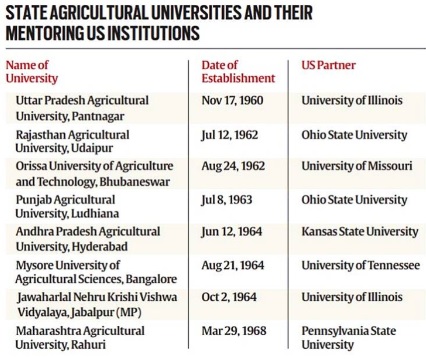International Relations
Indo-US Cooperation in Agriculture
- 14 Jun 2023
- 6 min read
For Prelims: Green Revolution, Indian Council of Agricultural Research (ICAR), ‘Norin-10’, Norman Borlaug, International Maize and Wheat Improvement Center or CIMMYT, International Rice Research Institute, Cold War, non-alignment, UP Agricultural University Act.
For Mains: International cooperation in agricultural development and ensuring global food security.
Why in News?
Examining the historical involvement of the United States in the agricultural progress of independent India holds significance within the framework of Prime Minister of India's imminent visit to the US.
- Like, Soviet Union’s role in independent India’s early industrialization through supply of capital equipment and technology, the United States (the institutions like of Rockefeller and Ford Foundation) played in India’s agricultural development through the establishment of agricultural universities and the Green Revolution.
What is Role of US in the Agricultural Development of India?
- Development of Universities:
- Govind Ballabh Pant established the first agricultural university in Pantnagar, Uttarakhand, based on the US land-grant model.
- This university integrated teaching, research, and extension services, aiming to provide an ideal environment for learning, problem-solving research, and knowledge dissemination to farmers.
- The university, later named G.B. Pant University of Agriculture & Technology, was inaugurated by Prime Minister Jawaharlal Nehru on November 17, 1960.
- Hannah's blueprint published by Indian Council of Agricultural Research (ICAR) led to the establishment of eight agricultural universities in India.
- The US Agency for International Development supported these universities with faculty training, equipment, and books. Each university had research farms, regional stations, sub-stations, and seed production facilities.
- Green Revolution’s Seeds:
- The Green Revolution (started by Norman Borlogue of US) entailed breeding semi-dwarf varieties with strong stems that didn’t lodge. These could “tolerate” high fertilizer application. The more the inputs (nutrients and water), the more the output (grain) produced.
- ‘Norin-10’, a short (grew to only 2-2.5 feet, as against the 4.5-5 feet height of traditional tall varieties) wheat variety, give 25% higher grain yields. Norman Borlaug crossed these with the spring wheats grown in Mexico.
- Traditional wheat and rice varieties were tall and slender. They grew vertically on application of fertilizers and water, while “lodging” (bending over or even falling) when their ear-heads were heavy with well-filled grains.
- M.S. Swaminathan, (scientist at the Indian Agricultural Research Institute (IARI) in New Delhi, got in touch with Borlaug who came to India only in March 1963.
- Borlaug sent the seeds of four Mexican wheat varieties bred by him, which were first sown in the trial fields of IARI and the new agricultural universities at Pantnagar and Ludhiana.
- By 1966-67, farmers were planting these in large scale and India, from being an importer, turned self-sufficient in wheat.
- Much of its wheat imports earlier, ironically, came from the US under its Public Law 480 food aid programme.
Why did the US Help India?
- Borlaug’s International Maize and Wheat Improvement Center or CIMMYT at Mexico was primarily funded by the Rockefeller Foundation. The latter, along with the Ford Foundation, also supported the International Rice Research Institute at Philippines.
- Both institutions contributed significantly to trebling and quadrupling grain yields, even as India, by the seventies and early-eighties, had built a robust indigenous crop breeding program – due to investments in the ICAR and state agricultural universities system.
- The idea of an MSP (minimum support price) and “a market within bullock-cart distance (for cultivator to sell goods)” was first pushed by a Ford Foundation team’s report of 1959.
- The Cold War geopolitics and great-power rivalry of those times resulted in competition to do-good, extending to “fighting world hunger” and sharing of knowledge and plant genetic material that were viewed as “global public goods”.
- India, contrary to popular perception, wasn’t aligned to either bloc at least till the sixties. The strategy of “non-alignment” paid off then, just as “multi-alignment” is today.
UPSC Civil Servies Exam Previous Year Question
Prelims:
Q. Norman Ernest Borlaug who is regarded as the father of the Green Revolution in India is from which country? (2008)
(a) United States of America
(b) Mexico
(c) Australia
(d) New Zealand
Ans: (a)
Mains:
Q. Why did the Green Revolution in India virtually by-pass the eastern region despite fertile soil and good availability of water? (2012)







